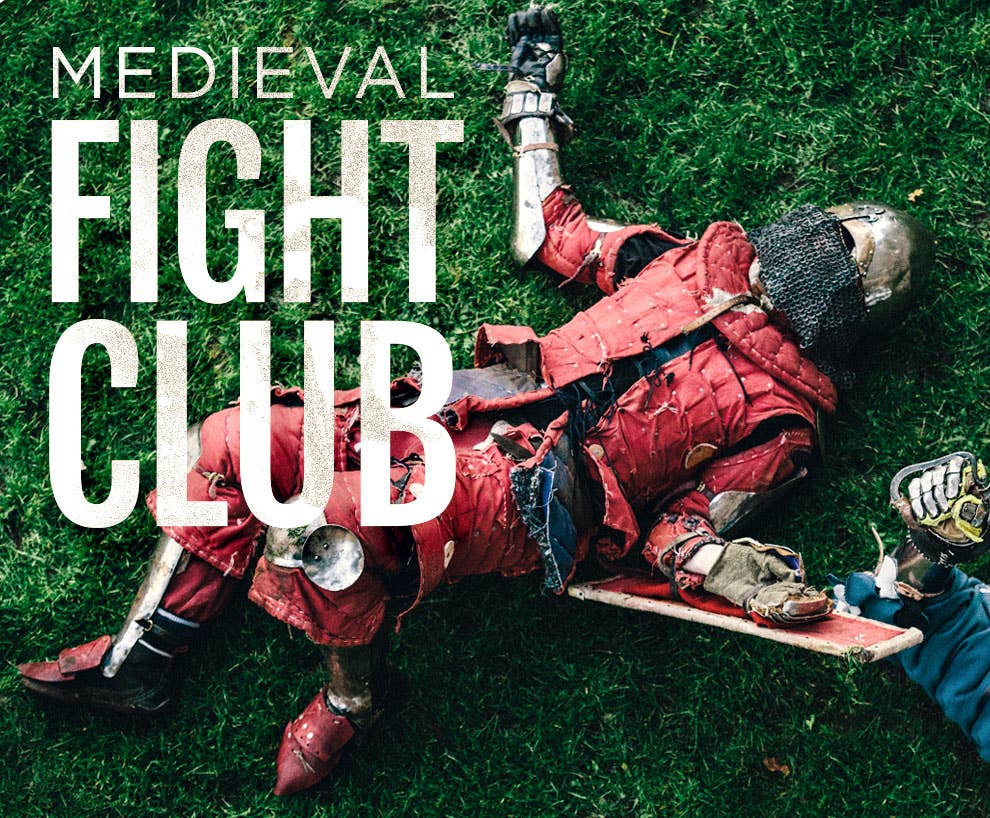
Combat is imminent at Caerphilly Castle. It’s a bright, chilly morning at the imposing 13th century fortification in South Wales, and we’re about to witness the kind of brutal violence this historic site hasn’t seen for half a millennium.
Huge, hulking men covered head to toe in glistening steel are sizing each other up, slicing immense swords through the air, or reacquainting themselves with the heft of their favorite axe. Visors are dropped with menace. We hear the fighters emerge before we see them, rattling sheets of chain mail echoing through the castle’s Great Hall before a long shadow announces another arrival. The courtyard shivers with anticipation as the arena fills with around 25 brutes.
A flag goes up, swords are raised, and any last prayers uttered before — wait. Someone’s missing. “He went to Morrison's for food,” a voice ventures. “He doesn’t have time to go to Morrison's,” another retorts. “Well, we can’t start without him,” a third decides.
And so the latest battle of Caerphilly is delayed while the missing fighter picks up provisions. There are a few more delays: Crowd barriers need readjusting; one warrior has a broken visor; another’s not wearing his helmet. But when war finally commences, it’s sudden and chaotic and instantly the stuff of George R. R. Martin’s most bloodlusty prose.
Steel kisses steel. Actual sparks fly. An axe snaps in half as it dents a helmet. A municipal garbage bin, carelessly left at the fringes of the fight, implodes in a sorry mess of dented plastic as four armored men collapse onto it.
I’m witnessing, from the far side of a flimsy rope, something much more violent than your average historical battle reenactment. These men are engaging in full-contact medieval combat in an open training session for Battle Heritage GB, one of twoUK-based national teams that are part of a growing, if fractious, global society. More GBH than LARP, it substitutes foam weaponry for real steel and scripted acting for unpredictable scuffling, and despite the mayhem, operates under tightly controlled rules and regulations.
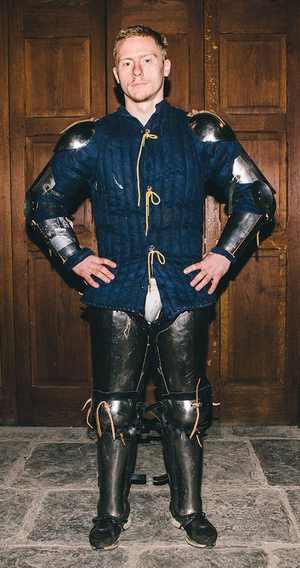
In the courtyard trouble flares again to the delight of a retinue of supporters in period garb. A huddle of bemused tourists cautiously joins them. Together we’re watching a series of organized fights that range from single combat to all-versus-all war. There are also 5-V-5 (five-a-side) and 4-V-4 battles, and the aim is to knock the other team to the ground — or until they have three body points touching the floor. Jabbing or thrusting with swords is strictly prohibited, but other than that, it’s essentially a free-for-all.
It’s a strange kind of fighting: Several tense and eerily quiet seconds as half-blind and almost immobile figures lumber toward one another, a brief tussle as their gauntlets lock and the opponents wrestle, then a demonic clanging as a third party sneaks up from behind to wallop them both on the back with an axe. It’s probably just like it was in ye olden past, minus the mud, plague, pestilence, rape, confusion, and shadow of Death’s huge scythe swinging indiscriminately above it all.
Within minutes, half of them have fallen. Griff Gigler, a 6-foot-5-inch mountain of a Welshman and team captain, takes a tumble over the crowd barrier, twisting his knee and knocking himself out for the rest of the day. “We’re a man down,” Martin Casey, the medieval MC, announces to the audience of around 15 people, adjusting his padded doublet.
Gigler throws off his helmet and explains to me the difference between today’s carnage and the scripted reenactment you might have encountered before. “That stuff is display fighting,” he says with disdain. “They have quite a lot of pride, but it’s all really Nerfed down and made safe.”
The team’s press officer, Nick Birkin, agrees. “Reenactors are used to dink, dink,” he says, mimicking the prissy swordplay anyone who’s sat through a retelling of Agincourt will no doubt cringe to recall. Another weekend warrior sums up the distinction more succinctly: “Reenactment’s for pussies.”
It’s difficult to tell how these fighters are feeling in the fray — their metallic slashing is more robot gone haywire than human combatant — but when it’s all over, and they pull off their helmets, their red faces are rinsed with exertion. For every two minutes of action there’s a good 15 minutes' rest, but soon the 4-V-4 gets going. Seconds later it’s over, a draw as the last two men head-butt each other and fall over simultaneously.
Caerphilly has seen worse. Today might not be as bloody as the Madog ap Llywelyn revolt of 1294 (or, let’s face it, the Llywelyn Bren uprising of 1316), but as another knight leaves the field with a face full of blood, it becomes clear this is a brutal pastime and that injuries are common.
“There were 450 fighters at last year’s Battle of the Nations championship,” Birkin says, referring to the annual contest that’s been held across Europe for the last few years, “and 64 of them had to go to the medical tent. One of our guys needed six stitches, and another snapped his arm.”
Team members have suffered broken bones and dislocated shoulders, and a patchwork of bruises is worn as a coat of arms. I overhear one particularly worrying account from a fighter talking about receiving a head blow from a pole axe: “My right vision completely went; there were sparkly lights and stuff. I spent a week in a brain-fog haze, walking around like a zombie.”
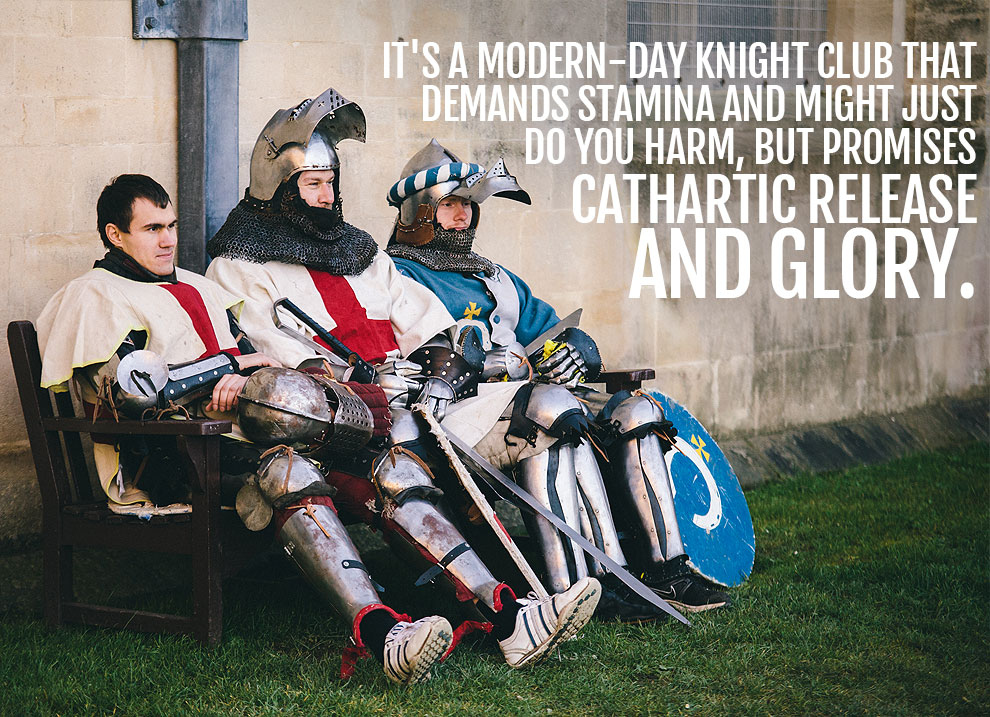
These injuries are all part and parcel of a fast-growing sport that began in Eastern Europe about five years ago among enthusiasts from Russia, Ukraine, Belarus, and Poland. They joined forces to form the Historical Medieval Battle International Association (HMBIA) and compete against one another at the Battle of the Nations.
Since the first fights at Khotyn Fortress in western Ukraine in 2010, the movement has spread across the globe like a plague from the Middle Ages, and by 2012, 12 nations were taking part, including Germany, Italy, USA, and Israel. By 2013, 22 countries had entered the fray and the U.K. made their debut as the battleground shifted west to Aigues-Mortes in southern France.
However, last year also saw a major split, as fighters from the U.K., U.S., and others decided to break away from the HMBIA to form their own organization amid accusations of cheating, corruption, and foul play. Countries are at war, and the battles taking place online are as vicious as the ones on the field.
The Americans, for a number of reasons, are spearheading a mass exodus from the HMBIA’s Battle of the Nations (BOTN) tournament, the establishment of a brand-new organization called the International Medieval Combat Federation (IMCF), and a new world championship to rival BOTN in Spain.
The new developments are all complicated and one big acronym-splattered mess, but they essentially boil down to this: A massive schism has occurred in the international medieval fighting community and there are now two major worldwide tournaments — and, in the cases of many countries, two national teams operating side by side. Tonight, these Brits need to vote on their future during a meeting I will not be allowed to attend. (You don’t argue with men holding maces.)
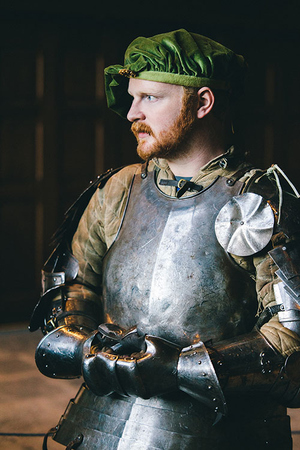
“They said that under no circumstances can you have a metal handle on your shield, and that you can’t wear titanium armor,” U.S. team captain Andre Sinou tells me later over the phone from his native New Jersey. Sinou is also the owner of an armory manufacturer called Icefalcon. “So I told my guys that. Then when we went out there, all the Eastern teams had metal handles. We complained, and they said, ‘Oh, we sent out a memo,’ which none of the Western countries got.”
Many of the Eastern fighters were wearing Kevlar armor under their suits and came with lethal equipment — such as two-handled halberd axes — that was banned for anyone else. “The weapons that some of the Eastern teams were using were just dangerous,” Sinou says. “They were pointy, they didn’t follow the rules for sharpness. After 2013, we had puncture wounds — we had a meaty guy who got punctured all the way down to the bone on the shoulder. It hit his spine. He could have been paralyzed.”
Nick Birkin echoes many of these complaints and adds his own stories of match fixing, detailing devious techniques that would put a Sochi figure-skating judge to shame and which apparently allowed Russian teams to progress further and enjoy longer rest breaks between contests. But the growing concerns of an increasing number of countries was met by a response almost laughably Kafkaesque.
“They said they’d put us on a committee, which would be headed by a Russian or a Ukrainian,” Sinou says. “They flat-out said they don’t trust somebody who’s not Russian or Ukrainian. This committee will report to another committee, and the head of that will be a Russian or Ukrainian. And they’ll report to a subcommittee, which will have a Russian or a Ukrainian at the head of it. And they’ll report to a presidium with their findings.”
For a sport that thrives on primal release and cathartic violence, it’s all a bit…mundane. “It’s typical Russian soviet socialist layering of bureaucracy,” Sinou concludes. Just who runs — or at least funds — the whole HMBIA thing is another topic of intense speculation, and I get everything from “some Russian oligarch” to “Russian mafia.” (The HMBIA has not responded to a request for comment, but did refer to this post addressing controversies.)
The issue of women fighting was another area of livid debate. The U.K., the U.S., and others are for it, but their opponents supposedly balked at the idea. “There was always this cultural thing: Women don’t fight, they’re camp followers, they do the cooking,” Birkin says. "I don’t know if they’re more worried about the shame of losing to a woman or whether it’s just different levels of violence.”
Sinou agrees, and reveals that the organizers finally agreed to allow one woman from each country, a paltry concession. The new IMCF tournaments will have a host of fight types available to women, and it’s a fast-growing demographic. In fairness, the HMBIA has also changed its tune and relaxed its rules, and the cover story for the latest Bohurt magazine, publication of choice for discerning HMB fighters, is titled "Women in Battle."
Many of the people I speak to list a litany of issues behind the rift, and each has a different straw that did break the camel’s back. However, the most frequently cited affront occurred at the last Battle of the Nations in May: During an epic struggle between Russia and the U.S., somebody reached through the fence and held up a Russian fighter by the belt to avoid him hitting the floor and losing the match. This would be bad enough for the honorable onlooking knights if it weren’t for the fact that the perpetrator was none other than Anton Trubnikov, captain of the Ukraine team, who subsequently denied the incident happened despite photographic evidence to the contrary.
Nations were up in arms, figuratively this time, settling scores on Facebook. As a final split became inevitable, Trubnikov began, in Andre Sinou from the U.S. team’s words, “a negative PR thing against the U.S., Poland, and Germany,” or as Birkin has it, “a dissemination campaign.” Spend a few minutes online and it becomes clear the war is being fought on numerous fronts.
However, this renewed aggression from the East has done nothing to quell the exodus. Fifteen countries instantly signed the new accord and Battle Heritage GB voted 36 to 4 to go with the new organization during their meeting. Fourteen of the 17 U.K. fighters who attended BOTN last year have split and are involved in the IMCF, while the former captain has remained to build a new crew.
Two more annual tournaments, in Bernau and Montbazon in Germany and France respectively, have pledged allegiance to IMCF. Of the teams that attended BOTN last year, only “Russia, Belarus, Ukraine, Israel, Australia, and maybe New Zealand are sending fighters of last year’s caliber,” Birkin says. He’s mostly concerned for the safety of any new teams that are formed to fight at BOTN, arguing that they’re being cobbled together at the last minute with insufficient training. (A spokesman for Battle of the Nations U.K. Federation responds: "We have one of the U.K.'s premier combat and fitness experts, Mick Coup, training our fighters and advising on technique.")
HMBIA top brass have since issued a statement entitled "Make HMB Not Rumors," which laments these “unhealthy changes in our information sphere” and attacks the West’s “chaotic emissions of information, provocations [and] publicly boasting boycotts … which completely contradicts the SPORTS spirit.” It also claims that their finances are audited by Kaiser Partner.
The diatribe ends with a postscript: “We can only guess how much negativity and pseudo-constructive criticism can appear in the comments for this article as some people try to turn their computer keyboard into a new battlefield.” There are no comments under the article.
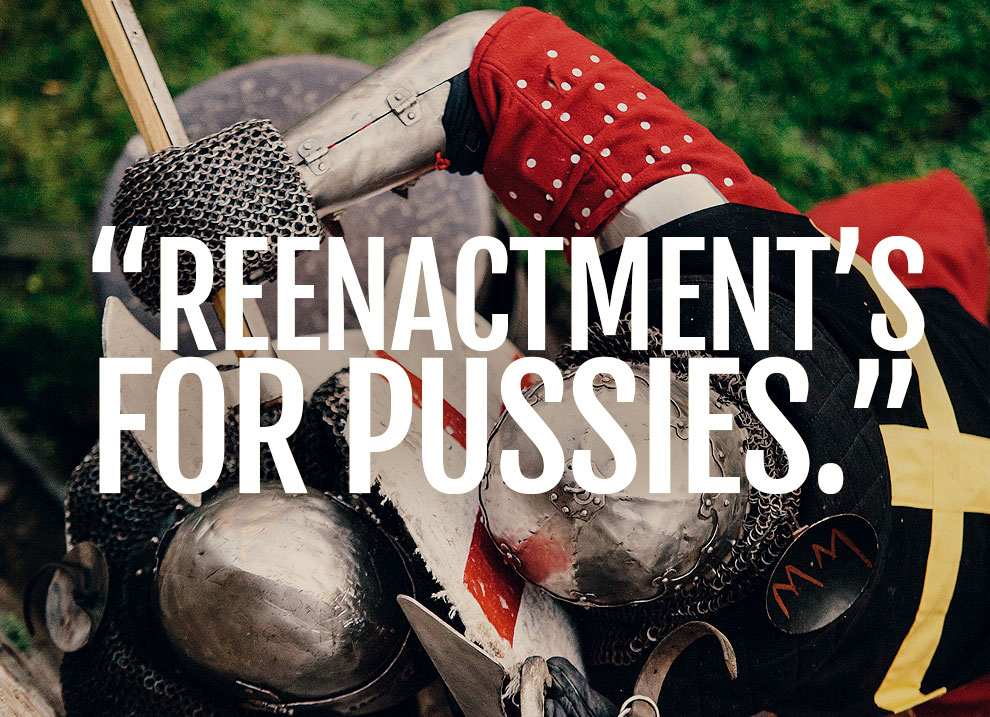
Back in Wales and with bloodshed on hiatus for a while, I head inside the Great Hall to meet some of the warriors. One particularly sinister knight throws his sword clattering to the floor and takes off his helmet. “Hi, I’m Tom Flint,” he says genially, offering a hand. Flint is 22, and a student studying creative writing with a focus on poetry. “I’m not aggressive normally,” he admits. “It’s always the quiet ones. When they get armor on, they become very, very violent.”
Flint puts on a green hat, scratches his gingery blonde beard, and talks us through his armor. He’s opted for your standard all-metal ensemble, and the steel scales that cover his arms gnash and scrape against each other menacingly as he talks, an incongruous complement to his soft voice.
“A lot of it has been made by blacksmiths, people who specialize in armory for reenactment," he says. "Quite a lot is imported because metal prices are so expensive here.” The whole getup can cost nearly $2,000. Swords vary from 50 quid [$84] to maybe £350 [$600] for a really nice one.” Is it heavy? “About five stone [70 or 80 pounds]."
As he talks, a miniature metal disc like a midget splash cymbal tinkles on his right thumb. It’s somewhat distracting. The room fills with weary people and I wonder who gets involved in this sort of malarkey — and why. “All sorts,” says Flint. “We’ve got a lot of people who work in IT; they’ve obviously got a lot of anger to work out.”
Nick Birkin sweeps his arm around the room and points people out. “That big Polish guy with the goatee? He’s a househusband. His wife’s a dentist. Nikolai, the English team captain, is a consultant engineer from Lithuania. Griff just graduated in some sort of oil-exploration mining thing. One of those guys makes computer games. We’ve got cage fighters, MMA fighters, and that bodyguard chap in the corner they found under a rock somewhere.”
Perhaps unsurprisingly, the military is well represented. Most teams have some serving or ex-army members, and this one is no exception. Sam Williamson has served two terms in Afghanistan and feels his rigorous training has helped his chances in the arena of medieval warfare and provided a team mind-set that’s invaluable when the visors go down. It’s also taught him how to lug a lot of armor around on his back.
“The best comparison was the nuclear, biological, chemical training we had,” he tells me. “You had a big, heavy, hot Teletubby suit on. On top of that you had all your kit and your weapons, your respirator and your gas mask, which restricted your breathing as it does when you’ve got your [medieval] helmet on and can’t breathe properly.”
While Williamson is reluctant to talk about his actual combat experience on duty, he agrees there’s a similar adrenaline rush between the two experiences. “There are definitely connections with the mind-set,” he says.
The voices that call out over the clang of chain mail dropping to flagstone are a mixture of British and Eastern European, and Birkin reveals that Battle Heritage GB have been criticized for their multicultural makeup. “Our opinion is this: We’re a multicultural society, their kids go to school here, they pay taxes here. They’re British.”
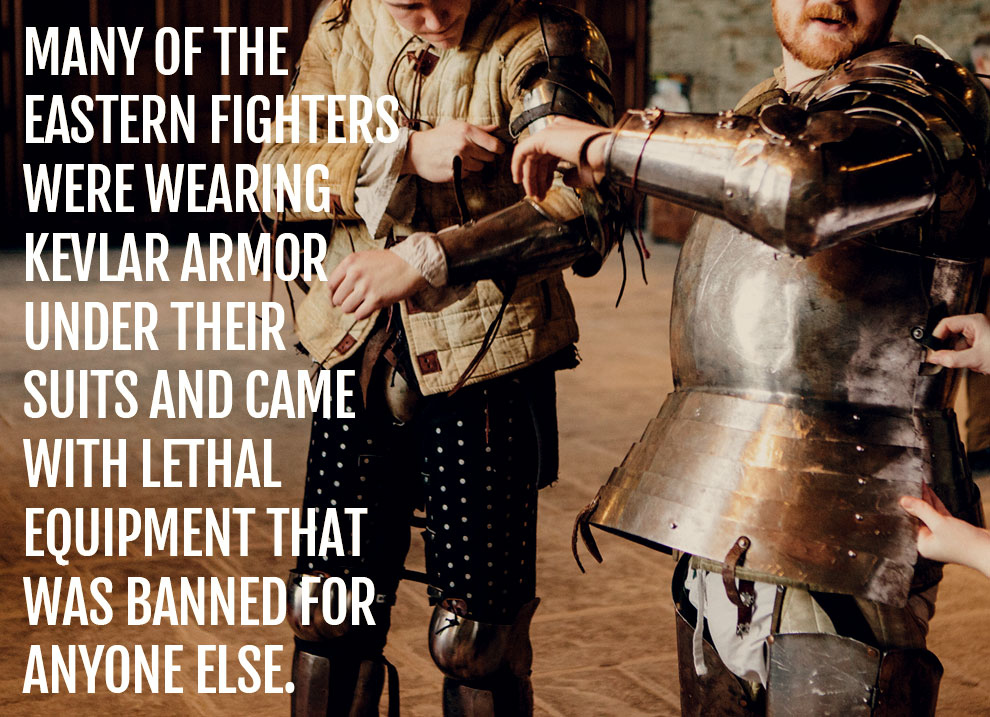
Someone puts some lute music on the stereo and I pick my way through discarded shields to meet armorer Joe Dawes, who claims he “hates the media.” He crafts weapons and armor full time, and is currently enamored with lighter combat gear covered in fabric padding and designed for wearing on horseback. “I do the armor for myself, and if anyone wants owt, I’ll mek it,” he declares in a thick regional accent. “Once you find an armorer, if you like his work you stick with him. Just like a tattoo artist.”
Every piece is handmade. A sword takes about two days and is forged to international-regulation thickness, at least 2 millimeters. It’s the kind of gear that would come in handy on some of London’s meaner streets. “The day will happen when some mugger picks on the wrong guy, just back from training,” agrees Birkin.
“There’s a period of around a hundred years you can choose from when it comes to armor,” he continues. “From the late 14th to late 15th century, it was the heyday for battles. You had your Agincourts, your War of the Roses. The whole of Europe was at war, and there was a nice bit of plague in the middle.” Flint defends their hodgepodge aesthetic. “The team doesn’t have to have a unified look,” he insists. “We’re not all portraying the knights of so-and-so.”
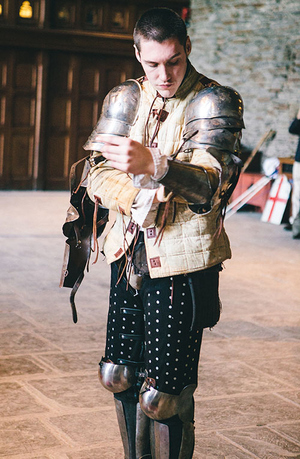
In the pub, the latest issue of Bohurt whiles away the time. (Cover price is $16, but free to download.) It’s an absorbing read, packed full of must-read features ("The Visored Barbute: Myth or Reality?," "The Executioner’s Sword — Part One"), interviews with various teams, and advertisements for historical glass beads and other retro paraphernalia.
It even offers a fitness guide over several pages: “In this article, we cover medieval man training with rocks. Rocks are easily obtainable, cheap, effective and offer a different feel to modern weights…” Incidentally, the team members I spoke to during the day mentioned all manner of fitness techniques, including strength and conditioning training, cardio sessions, fully armored combat, and whacking a pile of tires.
Tom Flint, my creative writing friend, had offered his own take: “Joe and I will go to a scout hut or a village hall and twat the fuckery out of each other.”

Night falls over Caerphilly and we return to the castle to sup mead heavily from an immense horn. There’s a feast lined up, and we’ve heard rumors of venison, pork, pickled vegetables, and other delights.
Expecting Baratheon levels of gluttonous debauchery and perhaps even a couple of dwarves racing pigs up and down the Great Hall, we’re excited, then eventually deflated when it turns out to be quite a sensible and humble repast. There is indeed plenty of Harvest Gold Mead, ample flayed and roasted flesh, and one wench who'd just returned from Afghanistan keeping our authentic wooden bowls full of sliced ham and spiced gravy, but it’s a pretty subdued affair.
Battle Heritage GB take their training seriously, so after a few conversations about the Wallace Collection’s excellent horse armor and a couple of slices of salted pig fat with some friendly Lithuanians, things start to wind down in preparation for the following day. Radiators get turned up, sleeping bags are brandished, and one guy beds down at 9:25 p.m. It turns out it’s just as well everyone turns in at sensible o’clock, as the Great Hall’s somewhat inauthentic strip lights are tripped by motion sensors and the room is woken periodically during the early hours by warriors heading out to the bathroom.
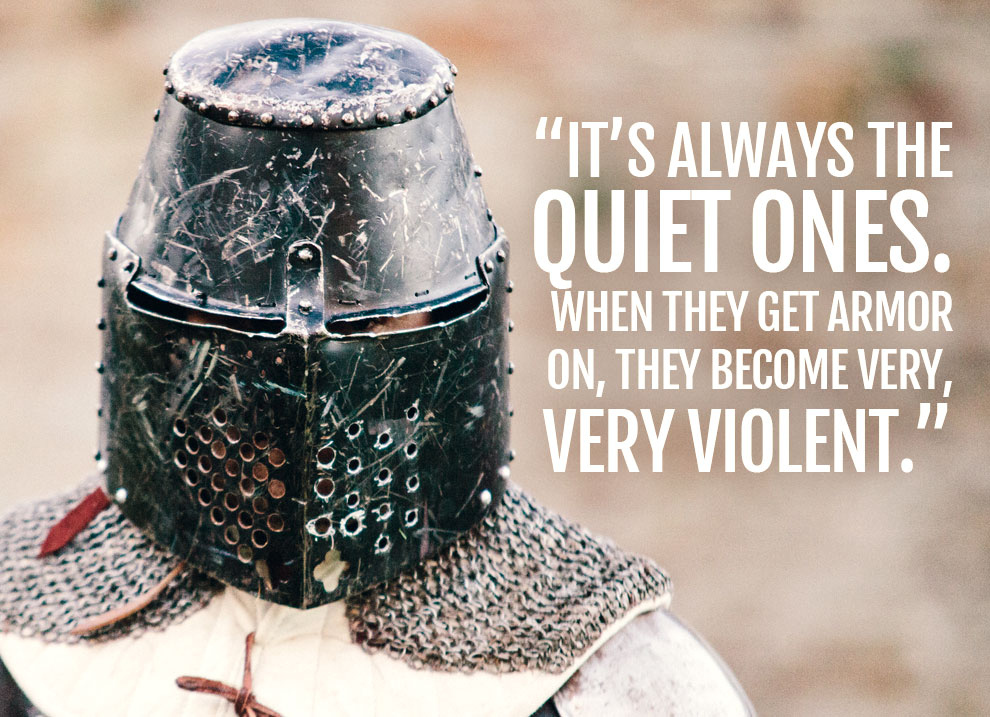
I rise at dawn. The lute music has been turned on again. There’s a video screen of a roaring fire being projected in the huge hearth. One wizened gent with long hair, who looks a bit old to be fighting but conveys unabashed enthusiasm in his fiery eyes, sits in a camping chair stirring a Nescafé.
Griff, the statuesque Welsh captain, hobbles toward the door, propping up his obliterated knee with a rustic stick. I follow him into the winter air to the heavy oak doors that keep Caerphilly from capturing the castle. He’s expecting someone from Dave’s Gym in Cardiff today, he tells me, breathing steam into the air.
Before long, angry steel clashes are mingling with traditional British bants across the castle courtyard as the honorable knights of Battle Heritage GB take up their training once again. After a while I get the impression I should tool up too, or go. I choose the latter.
On my way out I pass an affable onlooker in authentic period garb. Who might you be, kind sir? “I’m Hefin,” comes the reply.
And who have you come as? “I’m an affluent merchant, or a low-class knight. Or perhaps a man at arms,” Hefin says before running me through his hose, codpiece, calf-hide boots, and linen cap ensemble.
Not joining the battle today, Hefin? “It’s not for me,” he says in his gentle Welsh accent. “They fight very rough.”

Correction: A previous version of this story misstated the name of Battle Heritage GB.
